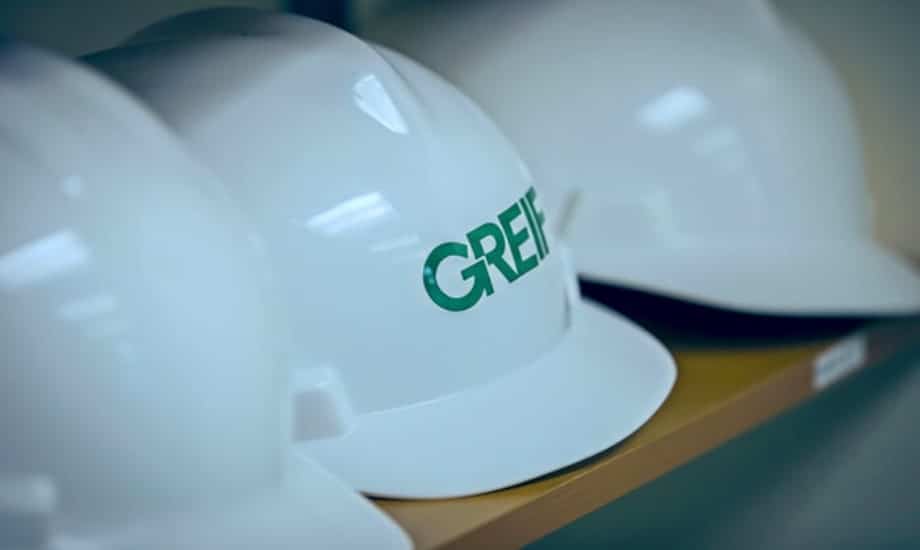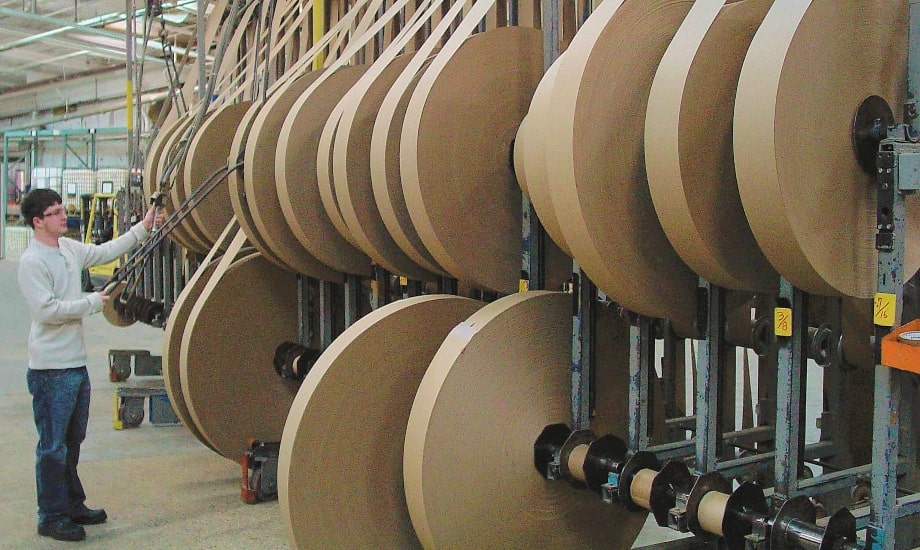- Sobre a nossa empresa
- Sobre nosso relatório
- Sustainability Strategies
- Goals & Performance
- ESG Reporting Indices
- Downloads de relatórios
Why Water Matters
Governance
77%
Reduction in Biochemical
Oxygen Demand
Our efforts in water quality have allowed us to already meet our 10% reduction by 2025 goal.
Global guidelines for water conservation and efficiency are provided in Greif’s Environmental Health and Safety (EHS) Policy. Each Greif facility is expected to manage water use in accordance with our EHS policy with supervision and support from Greif’s EHS team regarding compliance obligations and best practices for water use, treatment, and recycling. We have a centralized environmental structure that oversees our compliance management system and provides any necessary support. Local management teams are encouraged and empowered to improve water efficiencies and quality, reduce water withdrawal to minimize impact to local sources, maintain regulatory compliance and reduce costs related to water.
The majority (approximately 95 percent) of our water use occurs in 13 paperboard mills within our Paper Packaging and Services (PPS) business, as paperboard manufacturing is a water-intensive process. Consequently, our water management efforts primarily focus on these mills to obtain the largest impact possible. Greif strives to use reclaimed water whenever possible in paper production. Other examples of water reduction and quality projects undertaken at PPS facilities include:
- In 2021, we continued to invest in our efforts to eliminate direct discharge from our mills by converting our Baltimore, Ohio mill to discharging to a local municipal water treatment plant. In addition to removing direct discharge from our operations, this transition reduces Greif’s overall water withdrawal by 400,000 gallons a day.
- At our Fitchburg plant, we invested approximately $500,000 to install equipment designed to retrieve suspended air solids and reduce biochemical oxygen demand (BOD) and chemical oxygen demand (COD). This process has enabled us to improve water and air quality and reduce cost.
- In our Los Angeles mill, we installed a small HydroFlo Technologies Dissolved Air Flotation (DAF) clarifier, Hydrofloat, to reduce the amount of solids in wastewater and reduce facility expenses. The Hydrofloat recycles approximately 10,000 gallons of water a day.
- Our Fitchburg, MA mill installed and launched a much larger DAF near the end of fiscal 2021. This Evoqua Water Technologies DAF is over 100 square feet in surface area and capable of treating up to 300,000 gallons per day. By treating all the Fitchburg mill effluent, this DAF will reduce suspended solids (TSS) in our discharge by 80% and allow the mill stricter discharge limits in the future.
At our Global Industrial Packaging (GIP) facilities, water use is low. Our main focus is to follow good stormwater practices. These facilities conduct frequent stormwater sampling and testing to ensure safe limits and identify improvement opportunities. Stormwater training is another important component to responsible water management for Greif. All applicable employees receive annual training on Greif’s stormwater practices and compliance activities. We continuously update stormwater trainings, utilizing third party consultants where necessary. In 2021, we updated trainings at 9 facilities.
While Greif’s water impact is predominately in our PPS operations, it is still important to responsibly manage water use across all our operations, particularly in water-stressed regions, especially in Latin America, Africa and the Middle East. In these facilities, and throughout our operations, we reduce water pressure where it is higher than needed, replace leaky valves, recycle water, install touchless faucets and collect and use rainwater.
Greif monitors Key Performance Indicators (KPIs) to track water usage and ensure proper treatment of wastewater. In 2021, we continued to develop standard environmental data dashboards across our mills to better understand and manage water and effluents, as well as energy data, and to identify water efficiency opportunities.
Goals & Progress
In 2017, Greif announced a 2020 goal of a 10 percent reduction in kilograms of biochemical oxygen demand (BOD) per metric ton of production, from a 2014 baseline of 1.47, at legacy Greif mills. Our 2017 materiality process led to the creation of new 2025 goals and establishing our BOD goal for 2025. Additionally, in 2021, we worked to create 2030 goals and targets aligned with the American Forest and Paper Association. These goals will be shared in 2022.
In 2018, we reevaluated our historical water use and BOD data to confirm our baseline and assumptions to support continual improvement related to water. We restated our 2014 BOD baseline to 1.40 through this process.
2025 Goal: Reduce BOD discharged in kilograms by 10 percent per metric ton of combined production from the Riverville and Massillon mills using the 2014 restated baseline by the end of fiscal year 2025.
Progress: Since 2017, we have reduced BOD per metric ton of production by 77 percent in our legacy Greif containerboard mills.
Performance Data
WATER*
|
|
FY 2017 |
FY 2018 |
FY 2019 |
FY 2020 |
FY 2021 |
|---|---|---|---|---|---|
|
Water Withdrawal |
9,666.3 |
9,360.8 |
13,864.4 |
12,936.6 |
13,164.7 |
|
Surface Water |
9,242.7 |
8,630.0 |
10,266.8 |
10,132.0 |
10,274.8 |
|
Ground Water |
423.6 |
730.7 |
3,597.6 |
2,804.6 |
2,889.9 |
|
Rainwater |
- | - | - | - | - |
|
Wastewater |
- | - | - | - | - |
|
Municipal Water† |
- | - | - | - | - |
|
Wastewater Discharge |
8,983.2 |
9,316.2 |
12,403.92 |
11,935.1 |
12,013.53 |
|
James River |
8,788.8 |
8,907.1 |
7,949.5 |
8,375.0 |
8,324.8 |
|
City of Massillon |
191.6 |
407.1 |
424.0 |
355.8 |
400.9 |
|
Tuscarawas River |
2.8 |
2.0 |
2.5 |
8.8 |
69.0 |
|
Sweetwater Creek^ |
- |
- |
0.0 |
0.0 |
0.0 |
|
Cobb County WWTP^ |
- |
- |
844.9 |
855.0 |
854.9 |
|
Cincinnati Metropolitan Sewerage District^^ |
- |
- |
37.6 |
40.6 |
49.8 |
|
Milwaukee Metropolitan Sewerage District^^ |
- |
- |
349.0 |
335.9 |
328.4 |
|
Los Angeles County Sanitation District WWTF^^ |
- |
- |
196.8 |
189.1 |
214.9 |
|
Three Mile Creek^ |
- |
- |
0.0 |
- |
- |
|
Village of Baltimore WWTF** |
- |
- |
0.0 |
6.1 |
129.93 |
|
West Branch Paw Paw Creek** |
- |
- |
697.1 |
581.4 |
0.0 |
|
San Jose-Santa Clara Regional WWTP^^ |
- |
- |
288.1 |
334.2 |
383.2 |
|
Tacoma Central WWTP^^ |
- |
- |
6.9 |
8.5 |
10.9 |
|
City of Fitchburg WWTP^ |
- |
- |
322.6 |
309.0 |
298.7 |
|
Iowa River** |
- |
- |
291.8 |
364.9 |
341.3 |
|
Cherry Lake** |
- |
- |
597.8 |
550.4 |
479.7 |
|
Iowa Tributary** |
- |
- |
58.0 |
78.6 |
127.08 |
|
Biochemical Oxygen Demand |
890.4 |
204.2 |
3,508.3 |
3,457.1 |
3,823.8 |
|
Total Suspended Solids (kg) |
465,098 |
349,003 |
1,224,442 |
1,045,928 |
1,031,666 |
|
Phosphorus (kg) |
4,991 |
6,617 | 4,708 | 4,445 | 8,817 |
|
Production (MT) |
690,000 |
713,336 |
1,729,062 |
1,661,228 |
1,721,897 |
|
Consumption Rate (m3/MT) |
14.0 |
13.1 |
8.02 |
7.79 |
7.65 |
Notes:
- 2017 and 2018 data is from Greif’s two paper mills, one of which is located in Riverville, Virginia, and the other in Massillon, Ohio. Historically, these two paper mills accounted for more than 90% of Greif’s global water footprint. They draw from the James River and onsite water wells, respectively. 2019 data includes 12 former Caraustar mills that were acquired and integrated in 2019. All 2019 data is full year data. Quality of wastewater discharged from our mills meets permit requirements. No discharged water was used by another organization. WWTP = Wastewater Treatment Plant.
- FY 2019 data includes the Mobile Wright Smith WWTP, which was shut down in 2020, and been restated to properly account for FY 2019 West Branch Paw Paw Creek discharge.
**Treated with primary clarification, secondary clarification and aeration before direct discharge.
^ Treated with wastewater pre-treatment including soluble BOD removal.
^^ Treated with wastewater pre-treatment with solids only.
† Greif does not currently track withdrawal of municipal water.
|
Water Use in Regions With High or Extremely High Baseline Water Stress* |
FY 2020 |
FY 2021 |
|---|---|---|
|
Water Withdrawal (Thousands of cubic meters) |
170.4 |
109.93 |
|
Percentage of Total Water Withdrawal |
1% |
1% |
|
Water Consumed (Thousands of cubic meters) |
162.7 |
77.45 |
|
Percentage of Total Water Consumed |
16.2%** |
6.7% |
**Figure for FY 2020 amended due to previous error in calculation.
Practicing Circular Economy
At Greif’s Austell mill in Georgia, we began a wastewater residuals dewatering project to turn waste into biofuel. The circular economy practice sweeps thickened solids from a floating sediment blanket on to a dewatering press. The flowable solids are dehydrated until they can be transported to a location to air dry, mixed with other materials, and consumed as a supplemental boiler fuel. This process not only allows materials to be repurposed to gain the most benefit from start to finish, but it also saves the facility landfill disposal fees.

Water Reduction at Our Florence, Kentucky Mill
In late 2019, Greif’s Florence, Kentucky facility installed a wastewater treatment facility to reduce our hazardous waste load and recycle water back to the city. The process works by introducing water into the system, removing close to 100% of the pollutants from the paint process and sends the cleaned water to the local treatment plant. The water is then recycled by the treatment plant for redistribution to the community. The material leftover from the process is disposed via trash instead of hazardous waste. As the equipment came fully online in mid-2020, the process has not only significantly lowered hazardous waste generated by the facility, but also reduced the cost of waste by $40,000 a month.

SUSTAINABILITY HIGHLIGHTS
~95%
Of Water Use Occurs At Our 13 Paperboard Mills
We continue to invest in water reduction and quality projects at these facilities.
77%
Reduction in Biochemical Oxygen Demand
Our efforts in water quality have allowed us to already meet our 10% reduction by 2025 goal.
LINKS RÁPIDOS
Siga-nos
Se inscrever
Mantenha-se atualizado com as últimas inovações e novidades da Greif.
© Copyright 2022 Greif. Todos os direitos reservados.
Privacy Overview
| Cookie | Duração | Descrição |
|---|---|---|
| cookielawinfo-checkbox-analytics | Este cookie é definido pelo plug-in GDPR Cookie Consent. O cookie é usado para armazenar o consentimento do usuário para os cookies na categoria "Analytics". | |
| cookielawinfo-checkbox-funcional | O cookie é definido pelo consentimento do cookie GDPR para registrar o consentimento do usuário para os cookies na categoria "Funcional". | |
| cookielawinfo-checkbox-necessário | Este cookie é definido pelo plug-in GDPR Cookie Consent. Os cookies são usados para armazenar o consentimento do usuário para os cookies na categoria "Necessário". | |
| cookielawinfo-checkbox-outros | Este cookie é definido pelo plug-in GDPR Cookie Consent. O cookie é usado para armazenar o consentimento do usuário para os cookies na categoria "Outros. | |
| cookielawinfo-checkbox-performance | Este cookie é definido pelo plug-in GDPR Cookie Consent. O cookie é usado para armazenar o consentimento do usuário para os cookies na categoria "Desempenho". | |
| view_cookie_policy | O cookie é definido pelo plug-in GDPR Cookie Consent e é usado para armazenar se o usuário consentiu ou não com o uso de cookies. Ele não armazena nenhum dado pessoal. |
Use o Google Translate para escolher a sua língua da lista usando a barra de ferramentas no topo da página.

Procure esta barra de ferramentas na parte superior do seu navegador.



